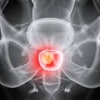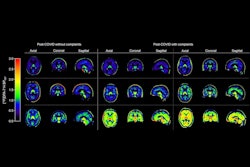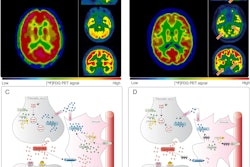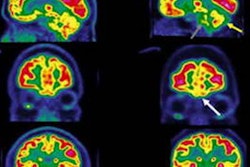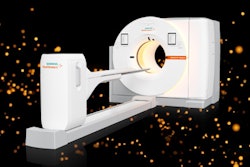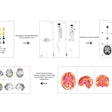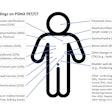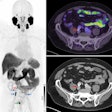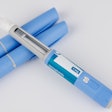PET imaging with a novel radiotracer has revealed a potential new biomarker and therapeutic target for memory impairments in patients with long COVID, Japanese researchers have reported.
The finding is from a study in 30 participants who showed irregular density of AMPA brain cell receptors (AMPAR) -- key molecules involved in memory and learning -- compared with 80 healthy individuals, explained lead author Yu Fujimoto, MD, of Yokohama City University, and colleagues.
“Using [carbon-11] K-2 AMPAR PET imaging, our study successfully revealed a systemic increase in brain AMPAR density in patients with Cog-LC, showing that the increased AMPAR density was associated with cognitive impairment,” the group wrote. The study was published October 1 in Brain Communication.
So-called brain fog occurs in up to 80% of patients with long COVID, yet little is known about the pathophysiology of the disorder. In this study, based on growing evidence, the researchers hypothesized that AMPA receptors on neurons may be involved. They noted that to date, no imaging technique has been available to monitor AMPAR activity in the living human brain.
The group first developed a new PET radiotracer called carbon-11 (C-11) K-2, which binds to AMPARs and allows visualization and quantification of AMPAR density. For the trial, the team enrolled 30 participants aged 20 to 59 with subjective cognitive impairment resulting from COVID-19 infection and ongoing symptoms affecting work, study, or daily life. In addition to PET scans, subjects underwent cognitive screening based on Repeatable Battery for the Assessment of Neuropsychological Status (RBANS) scores.
The primary objective was to compare C-11 K-2 PET-derived standardized radiotracer uptake value ratios between the patients with long COVID and healthy controls, and to define the regional extent of differences.
Compared with C-11 K-2 PET imaging in 80 healthy controls, a voxel-wise analysis indicated a statistically significant increase in radiotracer uptake across the brain overall as well as in specific regions of patients with long COVID, indicating increased AMPAR density, the researchers reported.
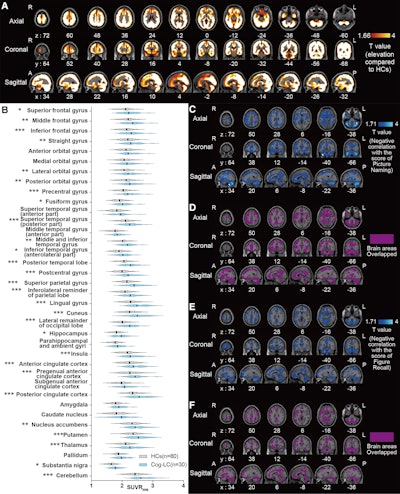 (A) Elevations in C-11 K-2 SUVR-WM in patients with long COVID memory impairment (Cog-LC) (n = 30) compared to healthy controls (HCs) (n = 80) (p < 0.05, T > 1.66, one-tailed, false discovery rate correction). (B) Multiple comparisons across Hammers’ VOIs between HCs (n = 80) and Cog-LC (n = 30). Bold line and dashed line of each plot represents mean and quartiles, respectively. *p < 0.05, **p < 0.01, ***p < 0.001 (Bonferroni multiple comparison test after two-way ANOVA analysis). (C) Brain regions showing a negative correlation between 11-C K-2 SUVR-WM and picture-naming scores of the RBANS in Cog-LC (n = 30) (p < 0.05, T > 1.71, one-tailed, false discovery rate correction). (D) Overlapping brain regions between the clusters in A and C. (E) Brain regions showing a negative correlation between 11-C K-2 SUVR-WM and figure recall scores of the RBANS in Cog-LC (n = 30) (p < 0.05, T > 1.71, one-tailed, false discovery rate correction). (F) Overlapping brain regions between the clusters in A and E. Abbreviations: A, anterior; P, posterior; R, right; L, left; FDRc, false discovery rate correction. Courtesy of Brain Communications
(A) Elevations in C-11 K-2 SUVR-WM in patients with long COVID memory impairment (Cog-LC) (n = 30) compared to healthy controls (HCs) (n = 80) (p < 0.05, T > 1.66, one-tailed, false discovery rate correction). (B) Multiple comparisons across Hammers’ VOIs between HCs (n = 80) and Cog-LC (n = 30). Bold line and dashed line of each plot represents mean and quartiles, respectively. *p < 0.05, **p < 0.01, ***p < 0.001 (Bonferroni multiple comparison test after two-way ANOVA analysis). (C) Brain regions showing a negative correlation between 11-C K-2 SUVR-WM and picture-naming scores of the RBANS in Cog-LC (n = 30) (p < 0.05, T > 1.71, one-tailed, false discovery rate correction). (D) Overlapping brain regions between the clusters in A and C. (E) Brain regions showing a negative correlation between 11-C K-2 SUVR-WM and figure recall scores of the RBANS in Cog-LC (n = 30) (p < 0.05, T > 1.71, one-tailed, false discovery rate correction). (F) Overlapping brain regions between the clusters in A and E. Abbreviations: A, anterior; P, posterior; R, right; L, left; FDRc, false discovery rate correction. Courtesy of Brain Communications
In addition, brain regions where C-11 K-2 tracer was significantly increased were negatively correlated with long-COVID patients’ picture naming and figure recall scores, which are RBANS subcategories, according to the results.
Finally, concentrations of various inflammatory markers were also correlated with AMPAR levels, which indicates a possible interaction between inflammation and receptor expression, the group noted.
“To our knowledge, this study is the first to suggest a potential relationship between synaptic functional molecules and cognitive impairment as a consequence of post-COVID-19 conditions,” the researchers wrote.
One implication of the findings is that suppression of AMPAR activity in the brain may be a viable treatment strategy for memory impairment in patients with long COVID, the group suggested. In addition, the study validated the use of C-11 K-2 PET as a diagnostic biomarker for identifying the condition, it added.
“Future studies should uncover why AMPAR expression increases, resulting in cognitive impairment, following SARS-CoV-2 infection,” the group concluded.
The full study is available here.



